The Origin of Species
In the late 1830s Darwin became increasingly convinced that species were not immutable. Instead, he thought they changed over long periods of time into new forms. He first called this his “transmutation theory.” After further reading and observation, he devised the phrase “natural selection” to describe the process whereby the species best suited to their environment survived, producing young that were similarly adapted to their surroundings. As Darwin was writing a large book compiling evidence for his argument, he received an essay from Alfred Russel Wallace who also described natural selection. After publishing Wallace’s essay in a paper that included his own ideas, Darwin was compelled to respond quickly by writing a shorter book than the one he had been working on. This “abstract,” as he called it, was published in 1859. One of the book’s strengths was its astounding compilation of facts supporting his theory of transmutation.
— Charles Darwin
 |
Alfred Russel Wallace. The Malay Archipelago: The Land of the Orang-utan, and the Bird of Paradise. A Narrative of Travel, with Studies of Man and Nature. New York: Harper & Brothers, 1869. First American edition. [zoom] The young naturalist Alfred Russel Wallace (1823-1913) also developed the concept of natural selection while living under conditions markedly different from Darwin’s. In the illustration, Wallace is watching the removal of a python which he had heard in the thatch of the ceiling during the night. |
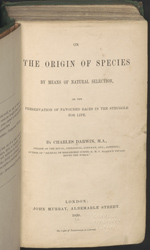 |
Charles Darwin. On the Origin of Species by Means of Natural Selection: or The Preservation of Favoured Races in the Struggle for Life. London: J. Murray, 1859. First edition. [zoom] |
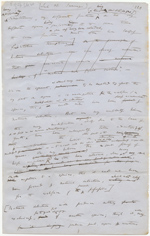 |
Charles Darwin. A leaf in the hand of Darwin from the original manuscript of On the Origin of Species. [zoom] | Additional images: 
Darwin labored over his text, and his handwriting is notoriously difficult to read. This page was eventually published as the beginning of the summary to Chapter 6, “Difficulties of the Theory”: “We have in this chapter discussed some of the difficulties and objections which may be urged against my theory. Many of them are very grave; but I think that in the discussion light has been thrown on several facts, which on the theory of independent acts of creation are utterly obscure . . . We are far too ignorant, in almost every case, to be enabled to assert that any part or organ is so unimportant for the welfare of a species, that modifications in its structure could not have been slowly accumulated by means of natural selection.”
On loan courtesy of Stephan Loewentheil and The 19th Century Shop, Baltimore, Maryland. |
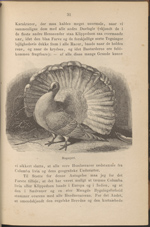 |
Charles Darwin. Om arternes oprindelse: ved Kvalitetsvalg eller ved de hedigst stillede formers sejr i kampen for tilvaerelsen; Efter originalens 5. udg. Overs. af J.P. Jacobsen. Kj°benhavn: Gyldendalske Boghandel, 1872. [zoom] The English pouter pigeon and English fantail pigeon, taken from Darwin’s 1868 Variation of Animals and Plants Under Domestication, were included in the Danish translation of the Origin. Some of the many foreign editions of the Origin encompassed changes authorized by Darwin, and others did not. |
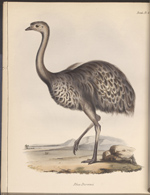 |
John Gould. Birds. London: Smith, Elder and Co., 1841. [zoom] Rhea darwinii, collected by Darwin in eastern Patagonia (Argentina). Darwin described three “great facts” of geographical distribution in the Origin of Species. One was the similarity of species on the same continent. While related, these species were found at different places. For instance, he noticed that the smaller species of the South American bird, Rhea darwinii, was replaced by the larger species (Rhea americana) to the north. He wrote, “We see in these facts some deep organic bond, prevailing throughout space and time, over the same areas of land and water, and independent of their physical conditions.” |
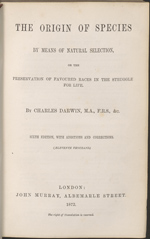 |
Charles Darwin. The Origin of Species by Means of Natural Selection; or, The Preservation of Favoured Races in the Struggle for Life. London: J. Murray, 1872. Sixth edition [zoom] During his lifetime, Darwin’s book went through six English editions, some of which included significant revisions while still retaining the overall concept of transmutation, which by the late 1860s came to be known as “evolution.” In 1872 Darwin published a less expensive and slightly smaller edition which he hoped would be more likely to appeal to the general reader. On loan courtesy of Stephan Loewentheil and The 19th Century Shop, Baltimore, Maryland. |